With its dazzling display of deep red leaves, it’s hard not to fall in love with the Philodendron Congo Rojo at first sight.
The Congo Rojo, often referred to as the “red velvet cake” of the plant world, is not only a stunner but also a breeze to care for.
We’ll dive into the world of Philodendron Congo Rojo care, exploring its unique color-changing features and ideal care conditions, and offering some useful troubleshooting tips for common challenges.
Get ready to add a splash of red to your plant family collection!
Table of Contents
Philodendron Congo Rojo Plant Care Guide
History, Habitat, and Characteristics
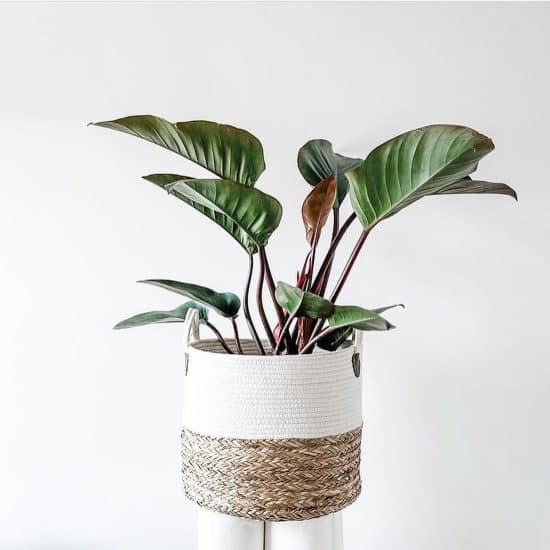
Philodendron Congo Rojo (Philodendron ‘Rojo Congo’) is a hybrid of Philodendron ‘Imperial Red’ and Philodendron tatei, which come from the tropical rainforests of South America. You’re likely to see it referred to as Congo Rojo and Rojo Congo — both refer to the same plant.
While it shares traits with a plethora of Philodendron species, this houseplant sets itself apart with its jaw-dropping coloration and texture. The plant’s large leaves, which can span up to an impressive three feet in length, boast deep grooves and striations that add an extra wow factor.
As the plant matures, its leaves transition from a brilliant green hue to a darker, almost burgundy shade, depending on light conditions. This color metamorphosis is a distinctive feature that adds flair and contrast.
(If you didn’t know burgundy green was a color before, well, you do now).
The Rojo Congo isn’t just a pretty face; it’s also known for its vigorous growth. In its natural habitat, in fact, these plants can reach towering heights of up to 10 feet.
However, when cultivated as houseplants, they typically stay within a more manageable two to three feet.
Unlike some of the more well-known species in the Philodendron family, like the heartleaf philodendron, Philodendron Rojo Congo has a non-climbing growth habit. It does display the tell-tale aerial roots of the Philodendron genus, but it won’t climb.
Fun fact: “Rojo” means “red” in Spanish, and “congo red” is a type of azo dye. So the name “Congo Rojo” takes inspiration from the plant’s red stems and leaves and its parents’ origins in South America.
Light
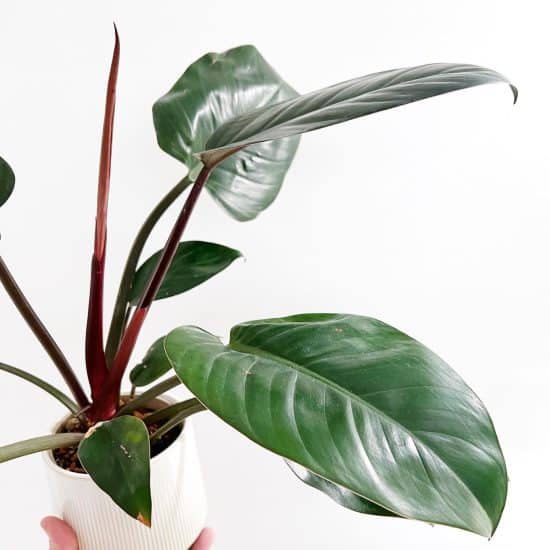
Philodendron Rojo Congos are tropical plants, so they need bright indirect light.
Like other tropical plants, they’re used to light from underneath a canopy and flourish when positioned near, but not directly in front of, a sunny window.
Close to an east-facing window or a few feet away from a west- or south-facing window is a perfect match for their lighting preferences.
While the Rojo Congo Philodendron can tolerate a limited amount of direct sun, it’s wise to avoid the scorching afternoon sun. Stick to gentler morning light to create the perfect ambiance without causing any damage to the foliage.
Especially when your new plant is settling in and you’re looking for the perfect location, keep an eye on your plant leaves to determine if the lighting is ideal.
Too much direct sunlight will cause leaf burn and yellowing, while insufficient light manifests as slow, leggy growth. You may need to relocate it a few times to find the perfect combination.
Our lighting tips:
- Avoid placing your Rojo Congo Philodendron too close to windows with direct sunlight.
- In an east-facing window or several feet from a west- or south-facing one is ideal for indirect light.
- Should you notice leaf yellowing or burns, don’t hesitate to move your plant to a shadier spot or add a sheer curtain to soften the sunlight.
- If you notice slow or leggy growth, boost indirect light by bringing your plant a little closer to the window or adding some artificial light from a grow lamp.
Water
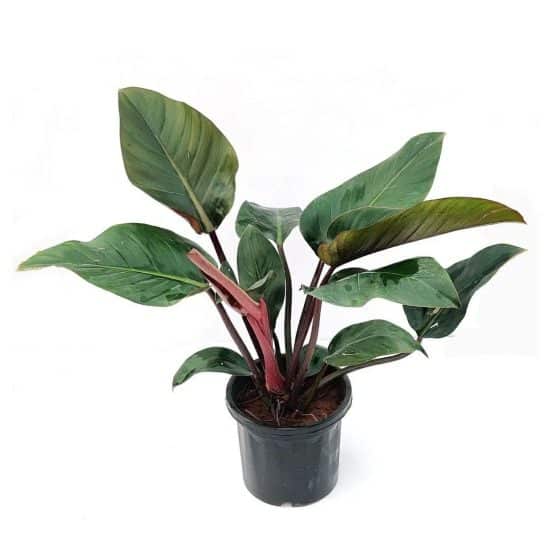
Philodendron Rojo Congo watering isn’t too tricky. Simply water your plant when the soil is dry. If the top two inches are dry when you insert your finger into the soil, it’s ready for a good drink.
Keep in mind, you want to keep the soil evenly moist. To keep the soil moist but not wet, wait for it to dry before you water again.
If you don’t water often enough, however, your Rojo Congo’s leaves may wilt, turn yellow, or droop.
To remedy this, increase the frequency of your watering schedule, ensuring that you wet the entire root ball during each session.
A good way to tell you’re giving Philodendron Rojo Congo enough water is to make sure water flows from the drainage holes. Then you know you’ve watered enough for the plant’s roots to get what they need.
But don’t water too often, or let your plant sit in excess water. Too much water can cause a soggy appearance, yellowing leaves, and rotting stems.
If you’ve overwatered by accident, simply let your plant dry out a bit by reducing your watering frequency and making sure your plant’s pot has proper drainage to prevent root problems.
You can let the soil dry out a bit more in the winter. When the plant isn’t actively growing, it uses less water. It follows that if you water as much in the winter as you do in the summer . . . it may lead to overwatering.
Our watering tips:
- Wait for the top 2 inches of soil to dry out before watering your plant.
- To check soil moisture, insert your finger about an inch or 2 into the plant’s soil.
- Adjust your watering routine according to the plant’s exposure to bright light and the current season. During the growing season (spring and summer), more frequent watering may be required, while winter months typically demand less water.
Temperature and Humidity
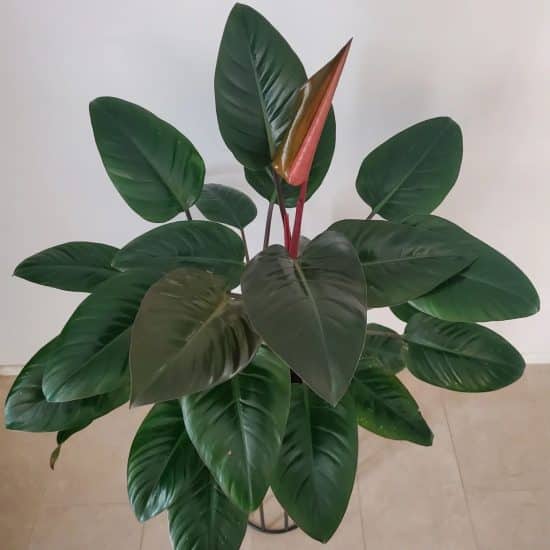
Philodendron Rojo Congo plants like an ideal temperature between 65 -80°F. Avoid exposing them to drafts from, say, air conditioning vents or cold windows. A key sign that the temperature is either too low or high is drooping or wilting leaves.
When it comes to humidity, the Red Congo Philodendron loves a humid environment, like any tropical plant — around 60% humidity is perfect. Beware seasonal shifts and indoor heating systems, which can lower humidity.
Brown leaf tips or dehydration are indicators of inadequate humidity around your plant. On the other hand, too much humidity can result in fungal infections and insect infestations.
It’s a delicate balance. The best way to prevent the effects of too much humidity is to promote air circulation around your plant while simultaneously raising humidity.
To raise humidity:
- Position a humidifier near your plant and run it daily.
- Place a pebble tray filled with water beneath the pot.
- Keep your Philodendron Rojo Congo close to other plants so they can share moisture through transpiration.
- Move the plant to a more humid room, like a bathroom, as long as it still receives enough light.
Soil and Planting
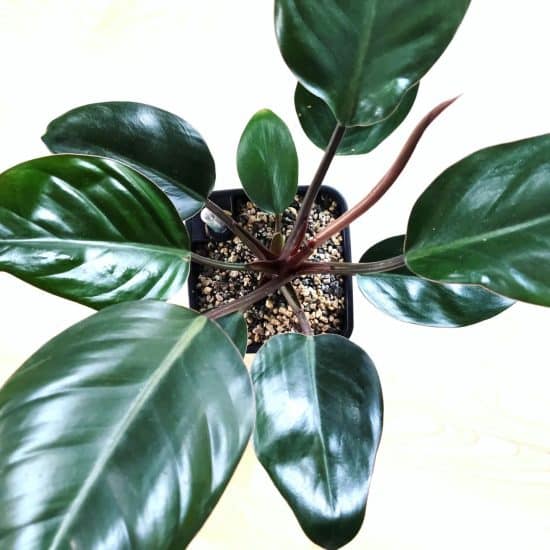
Creating the perfect environment for your Rojo Congo Philodendron starts with the right soil and pot. Use a well-draining, porous soil.
An ideal Philodendron Rojo Congo soil mixture includes several components, each playing a vital role in maintaining the perfect growing environment.
Here are some elements you should consider adding to your potting soil:
- Coconut coir. This ingredient helps retain moisture while providing a slightly acidic environment that your Rojo Congo Philodendron loves. It’s an environmentally friendly alternative to peat moss.
- Pine bark. Adding this maintains a chunky texture, improving drainage and preventing soggy soil, a common issue with overwatered plants.
- Horticultural charcoal. Improving water drainage and filtration, this element keeps your soil fresh and healthy.
- Grit. Including grit (kind of like gravel) in the mix promotes better drainage and supplies essential nutrients for your plant’s growth.
- Perlite. With perlite, you improve aeration and strike the right balance of moisture in the soil (key for happy roots).
It’s always best to let your plant live in its original nursery pot until it begins to outgrow it. When you do repot, choose a pot that’s only a few inches wider and taller than the original pot.
Any pot with drainage holes will do, but a clay pot (aka terracotta) will dry out quicker, whereas a ceramic or plastic one will retain moisture. Which you use should depend on your climate and other conditions around your Rojo Congo plant.
A pot that’s too big for your Rojo Congo plant will hold more water than the plant needs, leading to overwatering.
Try to repot at the beginning of the growing season when your plant is at its strongest.
Fertilizing
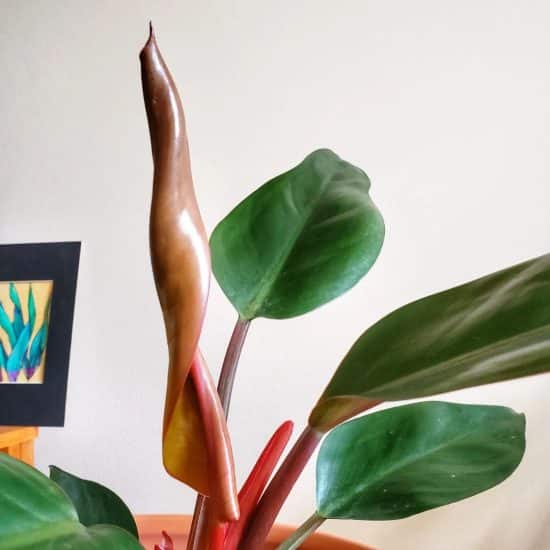
During the growing season, fertilize every other week with a well-balanced slow-release fertilizer diluted to 50%.
The best Philodendron Rojo Congo fertilizer will be one specifically for philodendrons, typically a 3-1-2 formula tailored to your plant’s needs. Organic fertilizer options, such as fish emulsion or worm castings, are growing in popularity.
Avoid fertilizing in winter, when your Rojo Congo plant isn’t actively growing. If it’s not using the fertilizer to grow, the fertilizer will build up in the soil, leading to toxicity.
Keep an eye out for signs of over-fertilizing (yellowing leaves, burned leaf tips, stunted growth). If these symptoms occur, flush the soil with water to wash away excess fertilizer and adjust future applications.
Propagation
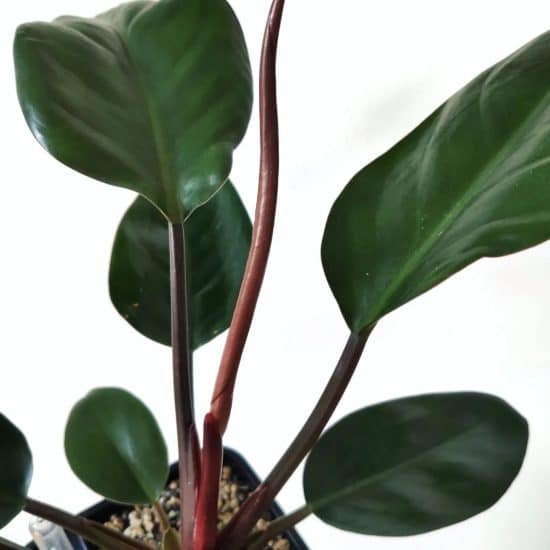
Propagating Philodendron Rojo Congo is such a rewarding process! Let’s dive right into propagating this houseplant using stem cuttings during the growing season.
Propagating Philodendron Rojo Congo via stem cuttings:
- Pick a healthy stem. You’ll want to choose a stem with at least a few leaves and no signs of damage or disease. A healthy stem leads to better propagation success!
- Snip that cutting. Grab your sterilized pruning shears or a sharp knife and cut a 4-6-inch section of the stem from the mother plant, just below a leaf node. This node is where new roots will develop.
- Prepare the stem. Remove any leaves from the bottom half of the stem to prevent them from rotting during the rooting process. Dip the bottom of your stem in rooting hormone if you have any on hand. It’s important to apply rooting hormone before the next step, not after.
- Let it callus. Next up, let the stem cutting dry and callus for a few hours. This little step helps keep any pesky bacteria or fungi away while the cutting’s busy rooting.
- Prep your rooting container. Fill a little pot with well-draining potting mix, and poke a hole in the center with a pencil or your finger. This hole should be deep enough to snugly fit the prepared stem cutting.
- Pop the stem cutting in. Now that your hole is good to go, place the calloused end of the stem cutting in it, making sure the bottom node is fully covered by the potting mix. Gently press the soil around the stem cutting for some extra support and stability.
- Give it some TLC. Find a spot with bright, indirect light for your pot and keep the soil consistently moist while the cutting’s rooting. To improve the humidity and encourage root growth, you can loosely cover the pot with a clear plastic bag or a dome. Remember to check for moisture periodically and give your cutting a gentle misting when needed.
Our propagation tips:
- Sterilize your cutting tools! This quick and simple action can prevent the spread of diseases, pests, and spider mites from other plants.
- Keep those cuttings out of direct sunlight — it can scorch their leaves and hinder root development.
- Patience, my friend! It might take a few weeks for your Philodendron Rojo Congo cutting to develop roots and show signs of new growth. So, hang in there and enjoy the process!
Common Issues
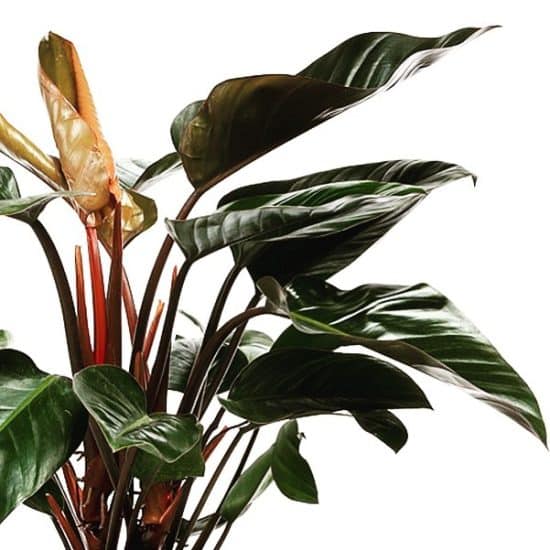
Philodendron Rojo Congo plants aren’t the most vulnerable of indoor plants, but they can face a few common houseplant issues.
Slow Growth
If your Philodendron Red Congo is experiencing slow growth, one likely reason is that it’s not getting enough light.
To promote faster growth, place your plant in a bright spot with indirect sunlight. It’s important to remember that indirect light doesn’t mean shade.
Another reason that a plant’s growth might slow down is that it’s ready for a new pot. When a plant outgrows its pot, the roots have nowhere to go, and they send a message to the rest of the plant to slow down growing.
Gently remove your plant from its pot (this is easier when it’s a bit dry) and take a look at the roots. If you can see roots growing on the outside and bottom of the soil, your plant is ready to be repotted.
Choose a pot a few inches wider and taller than the current pot and repot with fresh soil. Water your Rojo Congo well, and you should notice new growth and leaves emerge within a few weeks.
Pests and Diseases
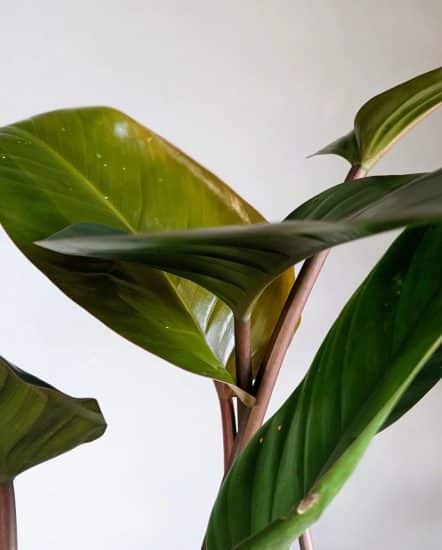
Philodendron Rojo Congo diseases are rare. It’s a resilient and low-maintenance indoor plant (no mythical green thumb required!), but it can still encounter some common problems, like leaf spots, the occasional pest, or the dreaded root rot.
Spots
Spots on a Philodendron Red Congo leaves can signal anything from too much sun to infections and everything in between. Begin by ruling out the most obvious culprits.
If the spots are brown or orange, your plant might be getting too much sun or insufficient water. Ensure you’re watering thoroughly when the top 2 inches of soil is dry and that your Rojo Congo is not in direct sun.
Inspect your plants leaves and stems for insects. If you find none, and you haven’t under- or over-fertilized, you could be dealing with a viral or fungal infection.
Mosaic Virus
Spotted leaves on your Philodendron Rojo Congo might signal pests or fungal infections. If the spots on your Rojo Congo’s leaves are yellow, however, you might be dealing with the mosaic virus, a known troublemaker for philodendrons, including our dear Rojo Congo.
Here’s a helpful trick: Mix a little neem oil extract, a drop of dish soap, and water together. Using a soft cloth, spray the solution and gently wipe the leaves (be gentle, you don’t want to damage them!).
Regular leaf cleanings not only keep your plant looking fresh, but also ward off potential infestations.
To tackle this issue, you might need to dig a little deeper with some research or consult a plant specialist. In the meantime, make sure your plant is soaking up enough sun and enjoys a consistent watering routine (happy plants are healthy plants!).
Root Issues
Issues with your Philodendron Rojo Congo’s roots might arise if it’s over-watered or sits in poor drainage. To avoid this, ensure your plant’s pot has proper drainage and is potted in well-draining soil.
If your plant’s roots do encounter a problem, quickly remove it from its pot, trim away any soft or slimy roots, and repot with fresh soil.
Remember, only water your plant once the soil is dry to the touch, water less in the winter, and never let a plant sit in water for more than an hour.
Fungus
Fungi can cause unsightly spots or mold on your Rojo Congo’s leaves and stems, usually as a result of too much humidity and poor air circulation.
Spotting signs of fungi? First and foremost, isolate your plant from others and grab a fungicide.
Follow the label instructions for the best results. Prevention is key: avoid over-watering and make sure there’s enough airflow around your plant (a little space to breathe never hurt anyone!).
It’s important to shield your Rojo Congo from excessive or intense sun exposure when it’s being treated with any fungicide. Failing to do so can lead to leaf scorch and plant shock.
Pests
While Philodendron Rojo Congo is quite pest-resistant, it can still have run-ins with common houseplant culprits like mealybugs, aphids, or spider mites. Keep a watchful eye on your plant for any signs of infestations.
Mealybugs are identifiable by the white, cottony substance that appears on your leaves and stems.
Spider mites love dry conditions and always set up wispy webs near the base of leaves and stems.
Aphids are pretty recognizable as beige to orange clusters of insects. All of these pests suck the sap — and the life — out of your Rojo Congo, so act fast.
If you spot any pesky bugs, isolate the affected plant and use an insecticide (always follow the directions on the product label). The neem oil, soap, and water solution mentioned earlier for cleaning leaves doubles as a bug repellent — keep a batch of it on hand at all times!
Conclusion
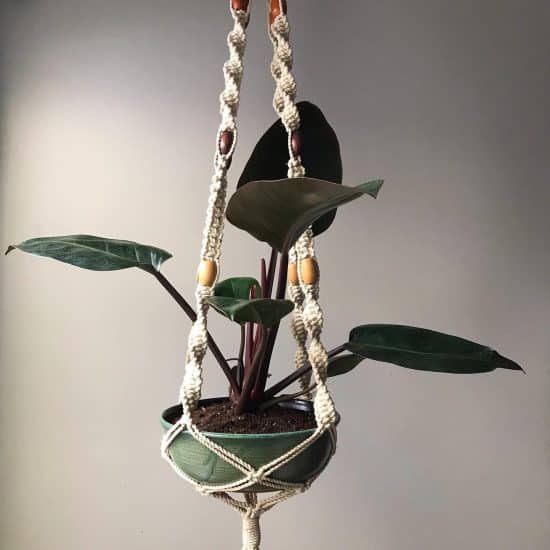
That’s a wrap for our Philodendron Rojo Congo care guide! With its stunning foliage and relatively low-maintenance nature, this houseplant will add some fun, easy color to your home (burgundy green for the win!).
By following our tips, you’ll be well equipped to keep your Rojo Congo healthy and thriving for years to come.
Philodendron Congo Rojo care summary:
- Provide a bright, indirect light source, ideally near an east-facing or several feet away from a south-facing window.
- Water consistently, waiting for the top two inches of soil to dry out before watering again; adjust the schedule with seasonal changes.
- Maintain a warm temperature between 65-80°F and high humidity levels around 60%.
- Use well-draining potting soil and an optimal mixture of coconut coir, pine bark, horticultural charcoal, grit, and perlite.
- Fertilize every other week during the growing season with a diluted, balanced fertilizer or one specifically formulated for Philodendrons.
- Propagate using stem cuttings during the growing season for the best results.
- Be mindful of common issues such as leaf spots and pests, and address them promptly to maintain the plant’s health.
We hope this guide empowers you with the knowledge to keep your Philodendron Congo Rojo in tip-top shape. Enjoy the lush, tropical vibes it brings to your home, and don’t hesitate to reach out to us with any questions or concerns.
Happy growing!
FAQ
Is Philodendron Rojo Congo toxic?
Yes. Philodendron Rojo Congo toxicity results from the calcium oxalate crystals its (and all Philodendron’s) leaves produce. Be sure to keep it away from curious pets and kids.
Can Philodendron Rojo Congo take full sun?
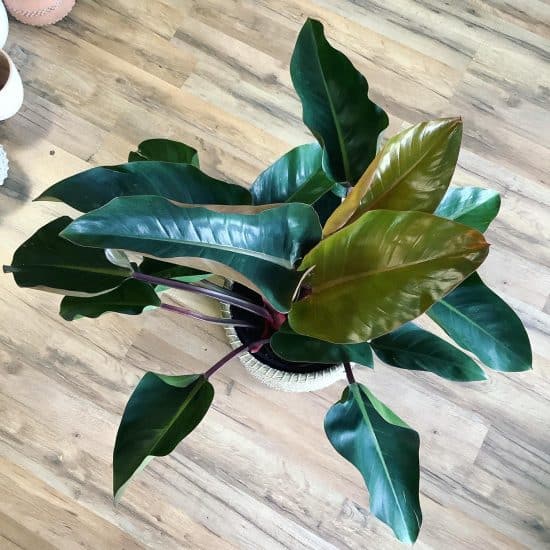
We don’t recommend it. This is a tropical plant that thrives in bright indirect sunlight — the key here being indirect. Dappled sunlight like the kind it would receive under the forest canopy is fine, but full sun can scorch this plant and is a no-no.


